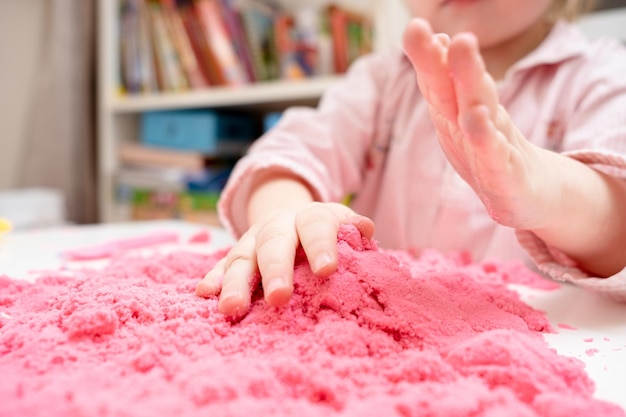How to Create a Sensory Bin for Exploration: A Guide for Early Childhood Educators
How to Create a Sensory Bin for Exploration: A Guide for Early Childhood Educators
Creating a #sensory bin is a fantastic way to engage young children in exploration, learning, and imaginative #play. Sensory bins are simple to make, customizable for different themes, and are an excellent tool for fostering curiosity, fine motor skills, and cognitive #development.
What is a Sensory Bin?
A sensory bin is a container filled with materials that children can explore with their senses. It encourages children to engage in tactile experiences, discover textures, colors, and shapes, and stimulate their creativity. Sensory play is beneficial for cognitive development, emotional expression, and building #early science and #math-concepts.
Steps to Create a Sensory Bin
-
Choose a Container
- Plastic bin or box: Select a shallow container so children can easily reach inside and explore.
- Transparent bins allow children to see the materials inside, while opaque bins can add an element of surprise.
-
Select a Theme
- Themes add a fun, educational twist to sensory bins. You can tailor the theme to seasons, holidays, or learning goals.
- Seasonal themes: Winter wonderland, autumn harvest
- Nature themes: Under the sea, jungle adventure
- Color themes: Red and green, rainbow colors
- Holiday themes: Halloween, Christmas, etc.
- Themes add a fun, educational twist to sensory bins. You can tailor the theme to seasons, holidays, or learning goals.
-
Pick Sensory Materials
- The base material should be easy to scoop, pour, or move around. Common options include:
- Rice or pasta: Colorful rice or pasta can add an exciting visual element.
- Water beads or sand: Great for squishy and smooth textures.
- Shredded paper or fabric: Adds softness and tactile exploration.
- Beans, pebbles, or pom-poms: Provide a variety of textures and sizes.
- The base material should be easy to scoop, pour, or move around. Common options include:
-
Add Tools for Exploration
- Include small items for scooping, pouring, and sorting to further engage children:
- Spoons, cups, and funnels
- Small toys or figurines to enhance imaginative play
- Nature items like leaves, rocks, or flowers for an #outdoor theme
- Include small items for scooping, pouring, and sorting to further engage children:
-
Set Up the Bin
- Arrange the materials inside the bin thoughtfully. Layer the materials or scatter items across the surface to create a visually appealing scene.
- Consider adding items like small containers, bags, or measuring cups for sorting, counting, or mixing.
-
Facilitate Exploration
- Allow children the #freedom to explore at their own pace. Ask open-ended questions to stimulate thinking and verbalization:
- “What happens when you pour the rice into the cup?”
- “Can you find something smooth and something bumpy?”
- “How does this feel in your hands?”
- Allow children the #freedom to explore at their own pace. Ask open-ended questions to stimulate thinking and verbalization:
Benefits of Sensory Bins
- Promotes Fine Motor Skills: Handling small objects or scooping and pouring helps develop hand-eye coordination and strengthens finger muscles.
- Encourages Language Development: As children describe what they feel, they practice new vocabulary.
- Supports Cognitive Development: Sorting, matching, and classifying objects are foundational math skills.
- Stimulates Creativity: The open-ended nature of sensory bins promotes imaginative play and problem-solving.
Additional Resources
For more tips and ideas on #sensory-play and #early-childhood development, explore additional articles and resources on ChildCareEd.com. Dive deeper into #early-education training, and explore online courses that focus on creating sensory-rich learning environments.
You can also check out these related articles on ChildCareEd.com:
Join Our Community
Stay connected for more tips, ideas, and support for #early-childhood- #educators! Follow us on our social media platforms for daily inspiration and resources:
- Instagram: @childcareed
- Pinterest: ChildCareEd
- Facebook: ChildCareEd
- TikTok: @childcareed
- X (formerly Twitter): @childcareed
By creating sensory bins, you can provide valuable hands-on learning experiences that spark children’s curiosity and development. Start building your own sensory bins today and watch your #students explore and learn through play!
- Early Childhood Education
- More than One Way to Look at it: Types of Early Childhood Education Programs
- Admin as Mentors in Early Education
- A Watchful Eye: Supervision in Early Childhood
- Conduct Disorders in Early Childhood
- Developmental Screening in Early Childhood
- Early Childhood Program Administration
- FAS in Early Childhood
- Language Development in Early Childhood
- Math Foundations in Early Childhood
- How to Create a Sensory Bin for Exploration: A Guide for Early Childhood Educators
- How CDA Council's Early Educators Leadership Conference is Shaping the Future of Early Childhood Education
- Zen and the Art of Early Childhood Education: Self-Care for the Educators
- Sensory Play in Early Childhood Education
- Guiding Little Learners: The Power of Mentorship in Early Childhood Education
- Pumpkin Spice and Sensory Delight: Easy Autumn Sensory Bins for Early Learners
- Exploring the Financial Constraints of Early Childhood Education Degrees
- How to Embrace the Unexpected: A Guide for Early Childhood Educators
- The Benefits of Early Childhood Education: Why Starting Early Matters
- Guide Spotlights Path To Early Childhood Education Careers
- Mastering Inclusive Education: Special Needs Training for Early Childhood Educators
- Mastering the Art of Emotional Intelligence: A how to Guide for Early Childhood Educators
- How to Encourage Creativity in Early Childhood Education
- Unlocking Potential: The Transformative Benefits of Early Childhood Education
- Effective Supervision in Early Childhood Education
- From Workshop to Classroom: How a CDA Credential Shapes the Future of Early Childhood Educators
- How Early Childhood Education Serves as a Pivotal Stage in a Child's Development
- The Importance of Outdoor Play in Early Childhood Education
- Why Professional Development Training is Worth the Investment for Early Childhood Educators
- The Critical Importance of Early Childhood Education
